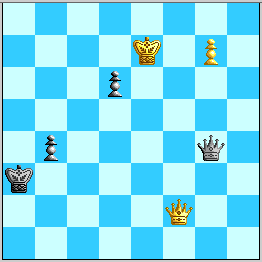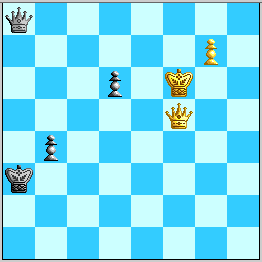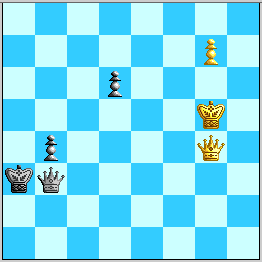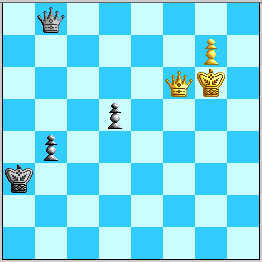
Diagram 1, White to move. To play Qf7 or not?

Diagram 1, White to move. To play Qf7 or not?
1. Qf7 Qe4+
Other checks lead to a quick win: 1...Qg5+ 2. Ke8 Qb5+ 3. Kf8 Qb8+ 4. Qe8+/-; 1...Qh4+ 2. Kd7! Qg4+ 3. Kc7+/- or 2...Qh3+ 3. Kd8 Qh4+ 4. Kc7+/-)
2. Qe6 Qb7+
3. Kf6 Qf3+
4. Qf5
Now 76...Qc3+ 77. Kg6 Qc4 (77...Qg3+ 78. Kf7 Qb3+ 79. Kf8+/-) 78. Qf3+! Kb2 79. Qf7 is the basic Qf7 win. Is this all Black has? No!
4. ... Qa8!

Diagram 2, White to move. This is a "little study": can you solve it?
5. Qg4! Qd8+
6. Kf7! Qc7+
7. Kg6 Qc2+
Instead, 7...Qd8/b8 8. Qe6 is +/-.
8. Kg5! ...
Now 8...Qc5+ 9. Kh4 is instant +/-, and 8...Qd2/c1+ 9. Kh4 Qh6+ 10. Kg3 is the same. And the desperate 8...Qh7 is met by 9. Qf3+ Kb2 10. Qf7+/-. However, an equally desperate-looking move poses White another challenge:
8. ... Qb3!

Diagram 3, White to move. This is also a "little study".
9. Qf5! and now:
This looks over, but Black has a way to be annoying that MacChess 5.0.1 found:
(h) 9. ... Qg3+
10. Kf6 d5!
10...b3 11. Qa5+ Kb2 12. Qd5!
11. Qe5!
Now 11...Qf3+ 12. Ke7 Qg4/g2 13. Qa1+ Kb3 14. Qf6 K-moves 15. Qf7 Qe4/g5/h4+ 16. Kd7 Qg4+ 17. Kc7 Qc4+ 18. Kb6! Qd5+ 19. Kb7+/- is fairly straightforward, but the other check is better.
11. ... Qf2+
12. Kg6 Qg2+
12...Qb6+ 13. Qf6 transposes.
13. Kf7 Qf2+
13...Qf1/f3+ 14. Qf6+/-.
14. Qf6 Qa7+
Now 15. Qe7 Qf2+ 16. Ke8 Qg1! may be inconclusive---note that 17. Qf7 is not a win with Black's King at a3, and Black has denied White a check on a7. And, 17...Qe3+ 18. Kd8 Qb6+ 19. Qc7 Qg6 or 19. Kc8 Qa6/c6+ 20. Kb8 Qb6+ 21. Qb7 Qg6! 22. Qa7+ Kb3! or 22. Qa8+ Kb2! is inconclusive. So White goes the other way.
15. Kg6 Qb8
15...Qg1+ 16. Qg5 Qb6+ 17. Kh5+/-, or 16...Qb1+ 17. Kf7 Qf1+ 18. Qf6+/-.

Diagram 4. Take advantage of the swap of Black Qa8,Pd6 for Qb8,Pd5.
16. Qf3+! Kb2
17. Qf7!
Black avoided 16...Ka4 because 17. Qxd5! is EGTB+/- #22, with the finish being 17...Qg3+ 18. Kf7'' Qc7+ 19. Kf8!'' Qf4+ 20. Ke8'' Qe3+ 21. Kd8' Qb6+ 22. Kc8'' Qa6+ 23. Kc7'' Qa5+ 24. Kc6!'+/- (EGTB annotation key). But now 17. Qf7 is the basic Qf7 win with a Black pawn on d5.
16. Kf5!? Qg3
16...Qc8+ 17. Kg5! Qc1+ 18. Qf4 Qg1+ 19. Qg4 Qc1/e3+ 20. Kh4 and soon +/-.
17. Qa1+ Kb3
18. Qd1+ Kb2
18...Ka2 loses the b-pawn with check, and 18...Ka3/c3 loses quickly to a 3rd-rank interposition following 19. Qg4.
19. Qg4! Qd3/f2+
20. Kg5 ...

Diagram 5. Point is that Black's d-pawn prevents ...Qd5+.
Now if 20...Qd2+ 21. Kg6 Qd3+ (21...Qc2+ 22. Qf5 Qg2+ 23. Kf7+/- or 22...Qc6+ 23. Qf6+ +/-) 22. Kf7 Qf1+ 23. Ke7 Qe1+ 24. Kd7+/- finally evades Black. The alternative shows how the "Cannon" theme works in classic fashion:
20. ... Qe3+
21. Kh4 Qh6+
22. Kg3 Qe3+
23. Kg2 Qd2+
24. Kf1! Qc1+
25. Kf2 Qc5+
26. Kg2 Qc2+
27. Kh1! Qh7+
28. Kg1 Qb1+
29. Kf2+/-.